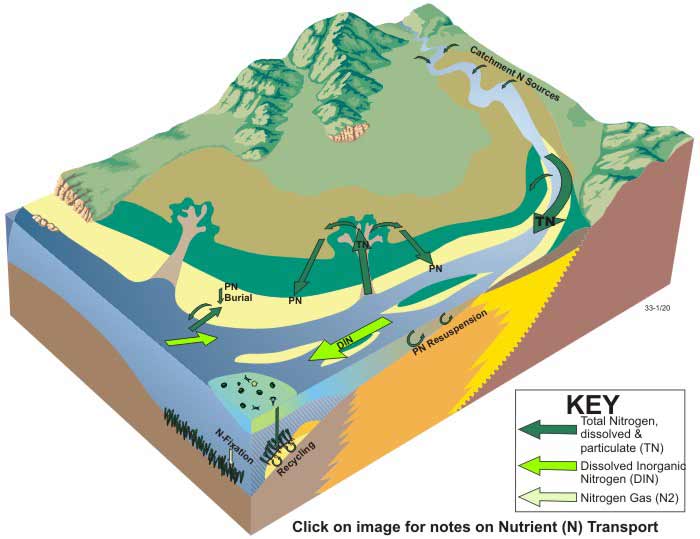
Nitrogen dynamic processes in tide-dominated deltas
1. Total nitrogen from within the catchment
Nitrogen, both particulate and dissolved or total nitrogen, enters the deltaic channels from point- and non-point sources from within the catchment. River flow and nutrient input varies regionally, depending on local catchment and climatic conditions. Typically, a high proportion of catchment-derived nutrient material is transported into estuaries and deltas (Harris, 2001).
2. Limited deposition
Limited deposition of particulate nitrogen occurs upon the sediments of the floodplain during high flow events. This process is enhanced by the effects of ‘baffling’ by floodplain vegetation. Biological uptake of dissolved inorganic nitrogen also occurs on the flanks of the river channel.
3. Mangrove sediment
Mangrove sediment is a net sink for dissolved inorganic nitrogen and particulate nitrogen (Alongi, 1996). Nutrient uptake is driven by high rates of plant productivity and microbial activity. N-fixation (incorporation of atmospheric N2 to form nitrogenous organic compounds) is active in the root-zone and contributes to the dissolved inorganic nitrogen pool (Kristensen et al., 1998). Some nitrogen is liberated to the atmosphere as N2 gas through denitrification (Rivera-Monroy et al., 1996, Trott et al., 2000). Particulate nitrogen is typically processed by sediment-dwelling biota such as crabs, or is exported to the coastal waters in the form of leaf litter and fine particulate matter (Ayukai et al., 1998). This material is redistributed during ebb tides and may be exported from the delta.
4. River-borne nitrogen
The majority of the river-borne total nitrogen is transported through the delta by strong downstream displacement. Deposition typically does not occur in the channels due to strong tidal and fluvial scouring. Penetration of strong tidal currents result in high turbidity in the deltaic channels, which tends to limit the activity of phytoplankton (Cloern, 1987, Monbet, 1992).
5. Tidal movements
Tidal movements on the flanks of the delta transport particulate nitrogen and dissolved inorganic nitrogen onto the intertidal flats (Alongi et al., 1999), where some of the dissolved inorganic nitrogen is converted to particulate nitrogen through the activity of benthic micro-algae.
6. Marine water exchange
A large proportion of the total nitrogen load is exported through the mouth of the delta into the marine environment. Assimilation of nutrients by phytoplankton the marine environment is typical, as turbidity levels become lower in the marine environment.


